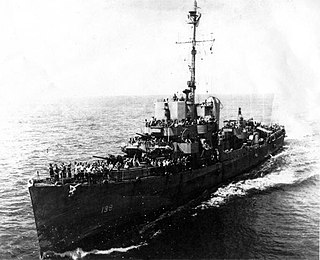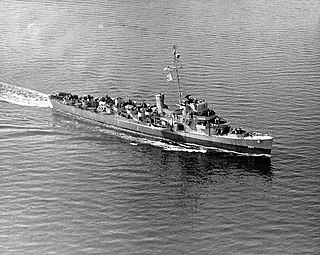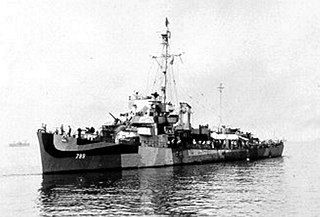
USS Dickerson (DD-157) was a Wickes-class destroyer in the United States Navy, and was converted to a high-speed transport at Charleston, South Carolina and designated APD-21 in 1943. She was named for Mahlon Dickerson (1770–1853), Secretary of the Navy from 1834 to 1838.

USS Guadalcanal (CVE-60) was a Casablanca-class escort carrier of the United States Navy, which served during and after World War II. She was the first ship to carry her name. She was the flagship of Task Group 22.3, a hunter-killer group which captured the German submarine U-505 in 1944.

USS Du Pont (DD–152) was a Wickes-class destroyer in the United States Navy during World War II, later reclassified as AG-80. She was the second ship named for Rear Admiral Samuel Francis Du Pont.

USS George E. Badger (DD-196/CG-16/AVP-16/AVD-3/APD-33) was a Clemson-class destroyer in the United States Navy during World War II; she was named for Secretary of the Navy George E. Badger (1795–1866).

USS MacLeish (DD-220/AG-87) was a Clemson-class destroyer in the United States Navy during World War II. She was named for Lieutenant Kenneth MacLeish.

USS Acree (DE-167) was a Cannon-class destroyer escort in service the United States Navy from 1943 to 1946. She was scrapped in 1973.

USS Forrest (DD-461/DMS-24), was a Gleaves-class destroyer of the United States Navy.

USS Huse (DE-145) was a U.S. Navy destroyer escort launched by Consolidated Steel Corp., Orange, Texas on 23 March 1943, during World War II. The ship was sponsored by Mrs. L. M. Humrichouse, daughter of Admiral Harry McLaren Pinckney Huse, whom the ship was named after and commissioned on 30 August 1943.

USS Bronstein (DE-189) was a Cannon-class destroyer escort in service with the United States Navy from 1943 to 1945. In 1952, she was sold to Uruguay, where she served as ROU Artigas (DE-2) until being decommissioned and scrapped in 1988.

USS Pillsbury (DE-133) was an Edsall-class destroyer escort in service with the United States Navy from 1943 to 1947. She served again as a radar picket ship from 1955 to 1960 and was sold for scrapping in 1966.

USS Farquhar (DE-139) was an Edsall-class destroyer escort in service with the U.S. Navy from 1943 to 1946. She was scrapped in 1974.

USS J.R.Y. Blakely (DE-140) was an Edsall-class destroyer escort in service with the United States Navy from 1943 to 1946. She was scrapped in 1973.

USS Fessenden (DE-142/DER-142) was an Edsall-class destroyer escort built for the U.S. Navy during World War II. She served in the Atlantic Ocean and the Pacific Ocean and provided destroyer escort protection against submarine and air attack for Navy vessels and convoys.

USS Swenning (DE-394) was an Edsall-class destroyer escort in service with the United States Navy from 1943 to 1946. She was sold for scrapping in 1974.

USS Cockrill (DE-398) was an Edsall-class destroyer escort in service with the United States Navy from 1943 to 1946. After spending decades in reserve, she was sunk as a target in November 1974.

USS Neunzer (DE-150) was an Edsall-class destroyer escort in service with the United States Navy from 1943 to 1947. After spending several decades in reserve, she was sold for scrap in 1973.

USS Jaccard (DE-355) was a John C. Butler-class destroyer escort acquired by the U.S. Navy during World War II. The primary purpose of the destroyer escort was to escort and protect ships in convoy, in addition to other tasks as assigned, such as patrol or radar picket. Post-war, she returned home with one battle star to her credit.

USS Jenks (DE-665) was a Buckley-class destroyer escort in service with the United States Navy from 1944 to 1946. She was scrapped in 1968.

USS Loeser was a Buckley-class destroyer escort of the United States Navy, named in honor of Lieutenant Commander Arthur E. Loeser (1903–1942).

USS Scroggins (DE-799) was a Buckley-class destroyer escort in service with the United States Navy from 1944 to 1946. She was scrapped in 1947.




















